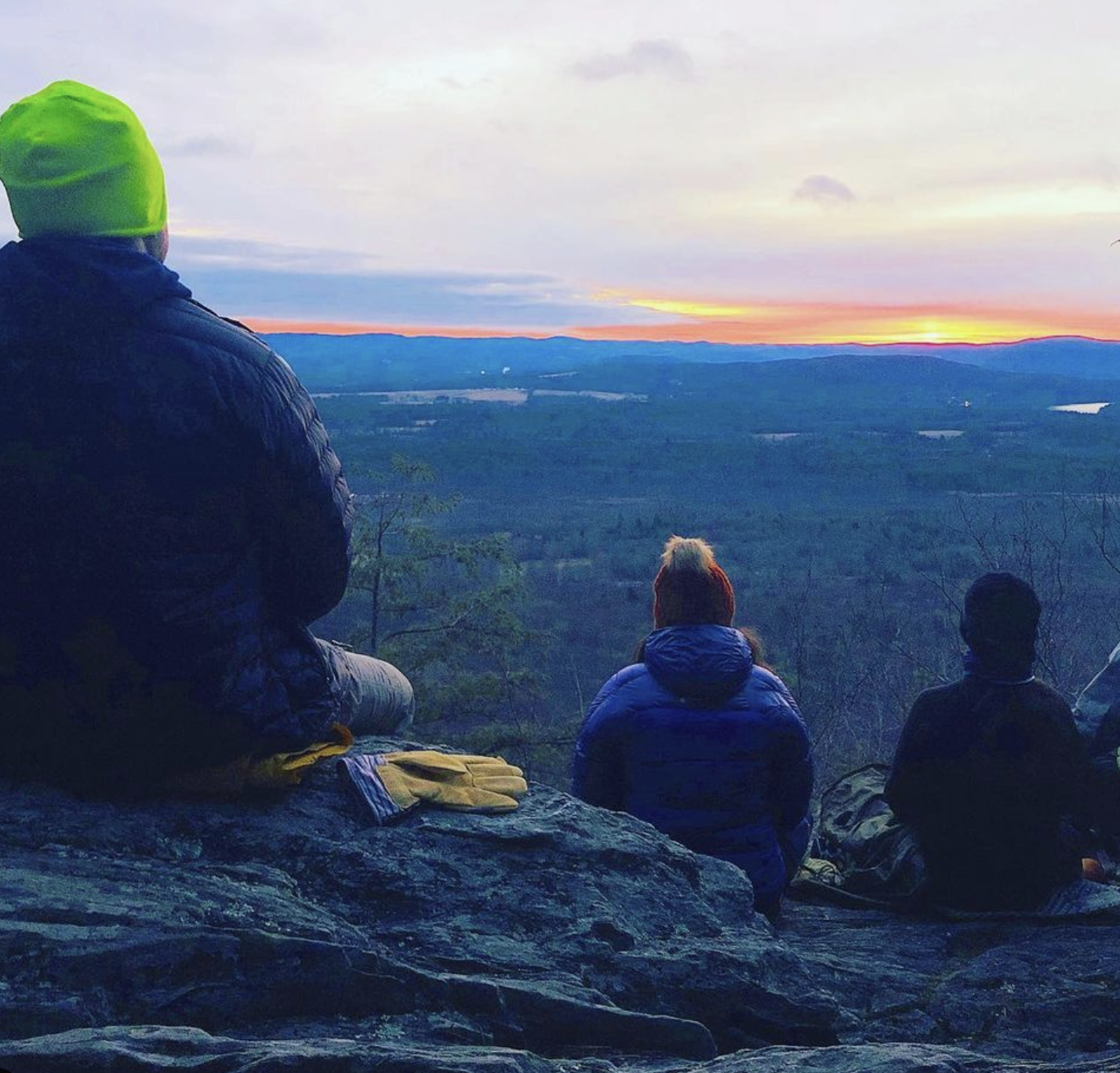It feels good to feel good. Outdoors, there are many activities in which we can engage that stimulate and inspire. In fact, the data is continuing to point to benefits of time in nature beyond prior scientific understandings. In a recent review of current research, scientists surmise that contact with nature does not simply positively impact our physiological health, but has a potentially profound impact on mood and mental health, increasing one’s sense of life purpose and meaning. These conclusions are no surprise. Many of us experience elevated feelings and emotions when we are struck with a sense of wonder or inspiration outside. This heightened condition of mind and spirit can be initiated by awe, can be defined as inspired, elevated positivity—a natural high, as opposed to destructive hedonism or fleeting pleasures.
When we reach the peak of a challenging two-day adventure to a beautiful summit with peers, or we share meaningful connection with friends in the surf at sunset, we may connect with a sense of awe. Defined as, “an emotion combining veneration and wonder, inspired by authority or the sacred” (Merriam Webster, 11th Edition, 2022), awe is profound and transformative. Some of our most poignant memories may be couched in awe—steeped in awareness and revelation. These are often life-changing moments. Awe rocks.
What is Awe?
The research shows that when we are outside, exposed to the expansive breadth of the natural world, and immersed in the beauty of immediate experience, we can connect with awe. Awe, now part of a larger understanding of the range of human emotions and feelings—demarcated in modern psychology—is a specific emotion being studied in relation to various areas including mental and physical health. Approximately 75% of the time, the emotional response defined as awe is positive and denotes clear responses, including improved vagal tone and decreased activity from the sympathetic nervous system.
The reality is, we are disconnected from the natural rhythm of life in our day to day. We’re pushing buttons, paying bills, swiping right or left, picking up groceries, waiting in line. It’s hard to connect with the universal truth or meaning of our existence when we’re checking boxes. When we slow down, we see the infinitesimal epoch of what’s happening here. Life is profoundly real, and the moments that remind us of our size—our scale in the greater scheme— give us context, give us awareness, and give us the immeasurable and necessary gift of perspective.
Awe and Mental Health
When we create space for ourselves to experience wonder and awe, we gain the gift of perspective and often that awareness is uplifting and inspiring. We see things from a different point of view, we see how unendingly beautiful the world is—we can feel ourselves in it. This elevates our mood and disposition. In addition, there are evidence-based health benefits beyond our, at times, limited understanding. Get this: awe is an anti-inflammatory.
“Of many positive emotions, self-reports of awe most robustly predicted lower inflammation, as indexed by the biomarker interleukin-6 (Stellar et al., 2015)…in addition, awe is associated with a profile of elevated vagal tone, increased oxytocin release, and reduced inflammation—all processes known to benefit mental and physical health.”
So, while many of us tend to think the harder we push, grind, or work, work, work, the better we are, the reality is every moment is an opportunity to find awe. We do not have to save the awe-moments for the annual vacation to Yellowstone or an occasional trip to the ocean, the reality is awe has a place in our daily lives. This is not about forcing monumental catalysts, but naturally integrating with our living environment intentionally and making space for conscious connection. Awe-some time. So, how do we do this?
Creating Space for Awe
Many of us have learned that our mental health needs more intention, attention, and space than outdated paradigms once posited. Mental health is gaining far greater prominence now as we come out of two and a half years of global pandemic and realize we need specific things in our lives to be happy and healthy. Good sleep, exercise, balanced nutrition, mindfulness or meditation, and connection are a few components. These are some of the elements going into our wellness. What about awe? Is it a core component of our well-being? Recent studies reveal that it is a key factor in mental and physical health.
This is evident in studies of increased optimism, sense of connection, and well-being; an openness to others and prosocial tendencies; reduced anxiety, depression, social rejection, and cardiovascular problems and autoimmune disease (Kiecolt-Glaser et al., 2002). Through awe-related shifts in inflammation, for example, or vagal tone, or reduced DMN activation, experiences of awe will likely benefit mental and physical health.
Awe as an Action Step
To answer how to frame awe in the context of day-to-day life we start with habits and behaviors. If we’re indoors, staring at the phone or computer, jumping from zoom to zoom, spacing out on TikTok, riding subways, or feeling disconnected and disjointed, our ability to find awe may be diminished. The first step to welcoming the awareness is to arrange our lives with our well-being in mind—in fact, at the fore. Many of us were not taught how to do this, but we learn. We schedule our time intentionally and with self-awareness in mind to create the possibility for perspective, awe, connection, and joy. Hence, this sets the stage for physical and mental health and wellness.
Awe Outdoors
Once in nature, we are open to possibilities, and we can do what we enjoy, often with people we love. Maybe we start the day with a simple walk around the neighborhood, a hike, a surf session, or a brisk trail run. Whatever it is, we do it. And we don’t just do it here or there, or when everything else works. It is part of our schedule, routine. We build around this connective tissue. What’s more, we aren’t checking emails and responding to texts when we’re out there (it’s OK, you’re not alone, we’ve all done it, but try not to and save that for later). If one is inspired to take a photo, go for it, but a gift to your mental health is to avoid being too plugged in when you want to tune in so maybe you do not post it online right away—give yourself the sacred space and wait until you are in a different environment. Let yourself be 1000% in the moment, especially if you’re with others. Observe through a lens of awareness and compassion and you’re given the gift of capacity—to witness, to share, to hold. It’s about connection, within and all around. Immerse in the vast spaciousness of the moment. This is where we start.
Awe arises in encounters with stimuli that are vast, or beyond one’s current perceptual frame of reference (Keltner & Haidt, 2003). Vastness can be physical, perceptual, or semantic and requires that extant knowledge structures be accommodated to make sense of what is being perceived. Recent daily diary work and more open-ended narrative work in more than 25 cultures found that people experience awe through encounters with other people’s courage and kindness, nature, collective gatherings (dance, rituals, and ceremonies), music, visual art, religious and spiritual practice, epiphanies, and birth and death (read the research: awe as a pathway to physical and mental health).
Experiencing Awe
Our typical understanding of awe is one of epic moments, where we travel far and wide, or something life-changing happens in any given moment. However, the truth is, we can connect with awe every day. Craig Anderson, a postdoctoral fellow at UC San Francisco and UC Berkeley who studies positive psychology, has shared his research finding that people don’t necessarily need extended outings or nature trips to experience significant changes in stress and anxiety.
Anderson’s study also looked at undergraduate students at Berkeley who took short walks outside and documented moments that gave them a sense of awe. He found that even these smaller moments still improved student well-being. The Nature Conservancy also recently published findings that even “microdoses” of nature within a city environment can still have a positive effect.
Daily practice starts one day at a time. We engage multiple tools—we pause, we move a muscle change a thought, and we change our point of view and thereby our state of mind. It sounds basic—and it is—but it’s not necessarily simple. It is a practice. We don’t come from the assumption that we will be endlessly immersed in elation and epiphany from all the “awe” we experience on the daily. But we set the stage for awareness and health when we give our consciousness the opening for awareness and creativity in the vast unknown. It is this simple.
“What’s so awe-inspiring for me about the outdoors is the perfect harmony of the natural world. Plants, trees, insects, animals—they all intertwine with no visible contrivance. That level of interconnectedness fills me with both awe and comfort. I can find that feeling on top of a snow-capped peak in the Alaskan backcountry, or in the woods behind my house—it’s everywhere.”
—Josh Flaherty, LMSW, Senior AR Guide and Executive Director
How to Incorporate Awe in Daily Life
Basic disciplines help us to carve out the space needed to incorporate wonder and awe. The idea is to cultivate healthy, sometimes new, habits in order to experience what we’re talking about. Here are some tips from the Adventure Recovery team.
Schedule your awe-time. It is important to carve out time each day to look up and unplug. This needs to be done away from screens, in nature. Even if you have a busy commute and a long day, find the time, whether it is the start of the day or the end. It does not have to be an extended period. Even a fifteen-minute walk in the trees helps. One of our friends likes to float in bodies of water—be it a lake or the ocean—and she always has her wetsuit at hand for dips all year long. This water and mental health immersion restores and revitalizes her sense of context and perspective. It fills the well.
Be open. When we are willing to have new experiences, challenges, and adventures, we create space for new sensations, feelings, and states of mind. This is more impactful than we may realize. Openness is characterized by being teachable. When we are teachable, we tend toward greater flexibility and less rigidity which is beneficial for a healthy lifestyle and mindset.
Share the awe with friends. Some prefer time alone but connection outside goes a long way. There are many opportunities to practice sport outdoors in camaraderie, sharing the joy of the moment. Surfers, paddlers, climbers, hikers, swimmers, SUP folks, runners—many of these activities can be done outside, with others for safety and support. This is building community and connectivity. We support one another, cheer each other on, challenge our skill sets, and celebrate our triumphs. What’s more, the experience of wonder with others can increase positive feelings and happy hormone production.
Get the gear. Whatever gear you need to ensure your favorite activity is easy, get it. Save up, keep spare items in your car, treat it all with careful attention and love. These items are precious tools to cultivate awe-inspired moments.
Try something new, outside. One of the easiest routes to having a new experience is doing something you haven’t done before. It can be scary but you’re not alone, we all start somewhere. For our mental health, we ensure we are with others we trust, with whom we feel safe. This is where teachable mind can be helpful, as well. The elevated experience of being in nature, combined with teachings, can be high impactful and empowering. This can facilitate awe, learning new things, climbing to new heights.
"Awe stops me in my tracks. It automatically shifts my perspective from the needs and wants built up by the daily hustle and into a mindset of gratitude and inspiration. It allows me to walk slower. It reminds me of what matters. That I'm a part of it all."—Nate Bennick, Senior AR Guide + National Field Director
Whatever method you choose, it may help to remember that we’re all a bunch of swirling atoms, riding a space rock through the universe into infinity. We are wonders of epic proportions, finite and yet intimately connected to the miraculous nature of existence. Here’s to recognizing the beauty and magic of it all, one day at a time.






